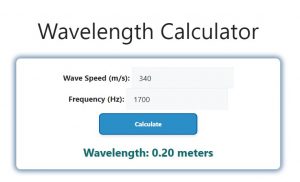About Wavelength Calculator (Formula)
Wavelength is an essential property of waves, describing the distance between two consecutive peaks or troughs in a wave. It plays a crucial role in fields like physics, engineering, and telecommunications. A Wavelength Calculator simplifies the process of calculating wavelength using the wave’s speed and frequency, allowing for quick and accurate results in various applications.
Formula
The formula for calculating the wavelength (w) is:
w = V / f
Where:
- w = Wavelength
- V = Speed of the wave (in meters per second)
- f = Frequency of the wave (in hertz)
How to Use
To use a Wavelength Calculator, you need to know the speed of the wave and its frequency. The calculator will use these values to determine the wavelength. Follow these steps:
- Enter the speed of the wave (V).
- Input the frequency of the wave (f).
- Click “Calculate” to get the wavelength (w).
Example
Let’s say a sound wave travels at a speed of 340 meters per second (V) and has a frequency of 1700 hertz (f). Using the formula w = V / f:
w = 340 / 1700
w = 0.2 meters
The wavelength of the sound wave is 0.2 meters.

FAQs
- What is wavelength?
Wavelength is the distance between two consecutive points in a wave, typically measured from crest to crest or trough to trough. - Why is wavelength important?
Wavelength determines many characteristics of a wave, such as its energy and the way it interacts with materials, making it critical in fields like optics, acoustics, and telecommunications. - How do I calculate wavelength?
You can calculate wavelength using the formula w = V / f, where V is the wave speed and f is the frequency. - What units are used for wavelength?
Wavelength is usually measured in meters, but other units like nanometers (for light waves) or kilometers (for long radio waves) can also be used. - Does wavelength affect wave energy?
Yes, shorter wavelengths typically carry more energy, while longer wavelengths carry less energy. - What is the wavelength of visible light?
The wavelength of visible light ranges from about 400 nanometers (violet) to 700 nanometers (red). - Can I calculate wavelength for sound waves?
Yes, using the speed of sound (around 343 m/s in air) and the frequency, you can calculate the wavelength of a sound wave. - What is the relationship between frequency and wavelength?
Wavelength is inversely proportional to frequency: as frequency increases, wavelength decreases, and vice versa. - How does wave speed affect wavelength?
The faster a wave travels, the longer its wavelength for a given frequency. Conversely, a slower wave will have a shorter wavelength. - What is the typical wavelength of radio waves?
Radio waves can have wavelengths ranging from millimeters to several kilometers, depending on their frequency. - Is wavelength constant for all waves?
No, the wavelength depends on both the speed and frequency of the wave. Different types of waves (e.g., sound, light) have different wavelengths. - How do I find the speed of a wave?
The speed of a wave can be found in the material or medium it travels through. For example, the speed of light in a vacuum is approximately 3 x 10^8 meters per second. - Can I use a Wavelength Calculator for electromagnetic waves?
Yes, the formula works for all types of waves, including electromagnetic waves like radio, light, and microwaves. - What happens to wavelength when a wave enters a new medium?
When a wave enters a new medium, its speed changes, and this affects the wavelength. However, its frequency remains constant. - What is the relationship between wavelength and wave period?
Wavelength is related to the period (T) of the wave, which is the time it takes for one full cycle to pass a given point. The period is the inverse of the frequency. - Does wavelength affect how waves interact with objects?
Yes, shorter wavelengths (e.g., X-rays) can penetrate materials more easily, while longer wavelengths (e.g., radio waves) may diffract or bend around objects. - What is a typical wavelength for microwaves?
Microwaves typically have wavelengths ranging from 1 millimeter to 1 meter, depending on their frequency. - Can I calculate the wavelength of a light wave?
Yes, by using the speed of light (3 x 10^8 meters per second) and the light’s frequency, you can calculate its wavelength. - How do I convert frequency to wavelength?
You can convert frequency to wavelength using the formula w = V / f, where V is the speed of the wave and f is the frequency. - Is wavelength the same as amplitude?
No, wavelength measures the distance between wave peaks, while amplitude measures the height or strength of the wave.
Conclusion
A Wavelength Calculator is an essential tool for calculating the distance between consecutive points in a wave, based on its speed and frequency. Whether you’re working with sound, light, or other types of waves, understanding wavelength is key to analyzing their behavior and properties. The calculator simplifies this process, making it easier to obtain accurate results in scientific and engineering applications.